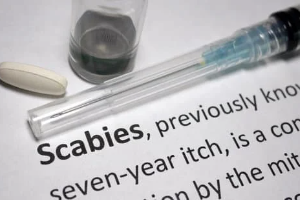Scabies is an infestation that affects the skin and is caused by a mite that burrows into the skin that, causes a red rash and itching. Scabies can affect people of all ages but is most common in children, and it is essential to note that scabies is contagious. Dr. Bornstein discusses the symptoms, diagnosis, and treatment of scabies.

DEFINITION:
Scabies is an infestation of the skin by a mite (a small insect).
SYMPTOMS:
The symptoms include itchy red spots with crusting, scaling, and burrowing lines. The rash in older children is mainly between the fingers and on the wrists, arms, and trunk. In infants, the rash primarily occurs on the head, neck, palms, and soles.
CAUSE:
A mite called Sarcoptes scabiei is responsible for this.
CONTAGION:
It is contagious from person to person until treated.
DIAGNOSIS:
The diagnosis is made by presentation of the clinical symptoms and appearance of the rash. The mite can be seen on a skin scraping under a microscope.
TREATMENT:
Treatment is accomplished by applying permethrin (Elimite), lindane (Kwell), or 10% crotamiton (Eurax) cream to the entire body, leaving it on for eight to twelve hours, then washing it off. All clothing, bed sheets, and towels must be washed in hot water or placed in a plastic bag for four days to remove the mites. Repeat treatment of permethrin and lindane should be done in 2 weeks (crotamiton in 2 days). If left alone, mites can exist off the human body for two to three days.
DISCUSSION:
Scabies are easily transmitted from person to person. Therefore, treating scabies is usually best to treat the entire family and their close contacts. Any itchy rash on multiple family members should prompt the diagnosis of scabies. Permethrin cream (Elimite) is the preferred treatment since it is less toxic. Lindane is used as well; however, not in infants, as it can cause nausea, vomiting, and neurologic symptoms. Crotamiton is a third choice. Hydrocortisone cream can help with the itching after treatment. Once the scabies is treated, all of the mites should be eradicated. The rash and itching may persist for another one to two weeks since many people are allergic to the bites and the stool left behind by the mites.
ONE DOCTOR’S OPINION:
The critical thing to remember when treating scabies is that the rash doesn’t go away immediately. If you kill a mosquito after it bites you, the bite doesn’t just disappear. The same is valid for scabies. I will always treat for scabies if a child has an itchy, excoriated rash that doesn’t respond to other treatments. Scabies looks a lot like eczema or atopic dermatitis. If a child with this diagnosis is not getting better with treatment, think scabies.
This blog was written by Dr. Michael Bornstein, who has 30 years of experience as a pediatrician.
Disclaimer: The contents of this article, including text and images, are for informational purposes only and do not constitute a medical service. Always seek the advice of a physician or other qualified health professional for medical advice, diagnosis, and treatment.


FOLLOW US